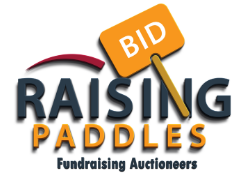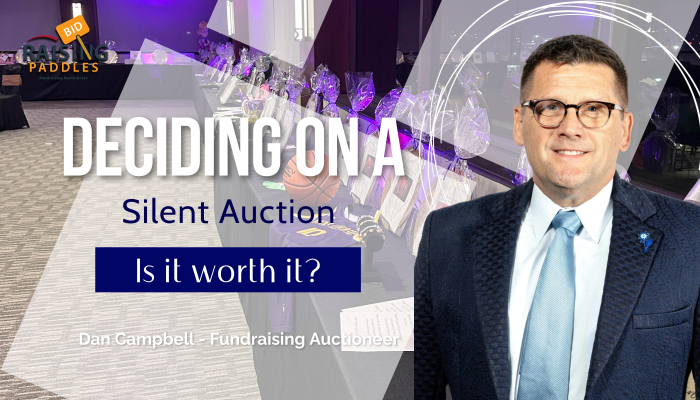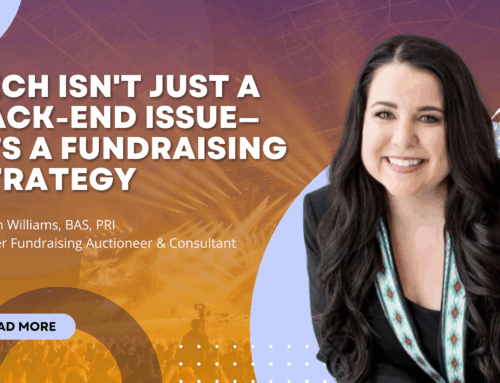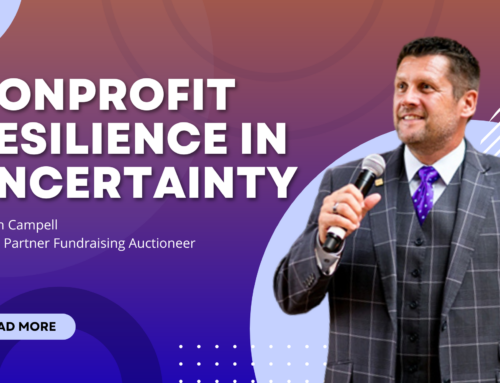One of the most commonly used fundraising elements to a fundraising event is a silent auction. Similar to setting up a retail shop, your attendees can browse the items and decide which ones they want and make a bid on them. Of course, different from a retail transaction, you are competitively bidding on the item, so you may have to bid again and again to ensure you win that item!
In today’s world, most of this is happening online through a mobile bidding platform, which allows attendees as well as people who cannot attend to competitively bid from their phone. Literally, a bidder who has the link to your silent auction can bid anywhere on the planet!
That said, silent auctions typically take a LOT of effort to put together, from procuring and soliciting items that are “worthy” for bidding, to staging the items, to preparing item descriptions and photos for displays, social media, and the mobile bidding platform. Then there is the promotion of the items, along with staging and setting up the items for display. Finally winners must checkout and pickup their items in a somewhat orderly fashion. Oh, and did we consider what has to happen for any items that go unsold?
Silent Auctions usually are where your donors go to get a bargain, as your average silent auction item will generate 65% of retail value. Thus, if you procure and solicit $10,000 worth in retail, you can estimate your result for the silent auction to be in the range of $6,500. It is key to manage your time and resources effectively, and avoid spending too much of your valuable volunteer time where the dollars are not significant.
A wise fundraising professional once said silent auctions take 80% of your volunteer effort, and only return 20% of your net proceeds. Because this is mostly true, many organizations have significantly reduced the number of items on display. In fact, some organizations have eliminated silent auction altogether, and put their focus on fundraising elements with greater return and less effort.
Setting up a game of chance is much easier to manage, less resources needed, and a good return on investment. Raffles are easier to manage due to less moving parts, and the ability to proactively engage your potential buyers. Again, the return on investment is better along with fewer resources needed.
Before you completely abandon the silent auction, let’s consider the space where a silent auction can still be an asset to your events. For example, golf outings and 5K runs have a lot of downtime where having a silent auction on display can be “something to do” when you are done participating. The silent auction can be open before and after the event and give continuity to your attendees to refocus their competitive juices towards your fundraising.
Schools still see silent auction success as parents and alumni, along with teachers and administration come together in a community effort to support the children. Many of the items can be artistic or school related, so they have value to those children and parents who are part of the school. Art, photos, sports and concert tickets to the school, preferred parking or seating, etc….all have value that make a silent auction successful.
If you are part of an organization that historically relies heavily on a silent auction, and you are looking for ways to replace that revenue with an easier fundraising element, you can start by reducing number of items in a few different ways:
- Bundling – instead of several items that may have a value of $25-$50, putting similar items together can make an attractive package. For example, by putting together a spa package with several items, including gift cards together, you can increase the value and reduce the number of items being staged at the same time. A bonus here is once you bundle, the math gets fuzzier for the bidders, and they may perceive a higher value than individually!
- Move some items to a different fundraising element, such as a game of chance. For example, take 50 items that would have brought $35 each (a total of $1,500), and then host a game where people pay $20 per ticket, sell 100 tickets and raise $2,000!
- Replace many smaller items with a larger value package, such as a beach vacation. Throw the beach item related donated items in with the vacation to make it more appealing both in display and value.
One last idea that might be an alternative to your silent auction is called a Vacation Station. This has been a significant trend the past 12 months. Here’s how it works: select 6-10 travel and experience destinations, either donated or procured and list them on your fundraising page for mobile bidding access. Set up a table display with posters that describe each trip with instructions on how to purchase at a set price.
The idea is to create a Buy-it-Now offer with a set price for each item. The goal is to sell each package to net $1,000 per item sold. For most procured consignment items, you can sell multiples, so selling 10 or more packages is more likely. Sell 10 packages on the Vacation Station, and you have just netted $10,000!
Vacation Station implies that the donors who give to your cause also have a budget for travel and experiences. They want to give but may have never considered buying their next vacation through your nonprofit organization and at the same time helping your cause even further. Think about it: if a donor plans to vacation in the next 12-24 months, why not offer them exciting destinations to consider in your Vacation Station?
You will want to provide a variety of packages that appeal to different interests through your fundraising platform. Some prefer local travel, while others favor international trips. Options should include beach vacations, family getaways, and couples-only retreats. Additionally, consider sporting events, concerts, and special occasions. Your Vacation Station should offer various choices to appeal to the largest percentage of your attendees.
You can find ideas for Vacation Station at this site: https://missionfirstfundraising.org/categories/ Pick one or two options from each category. Here is an example of a typical Vacation Station. Simply mark each of these up by $1,000 from the procurement cost, and you will successfully raise money for your cause:
1. Tennessee Jack Daniels Tour: https://missionfirstfundraising.org/events/tennesse-whiskey-jack-daniels-tour/
2. Lake Tahoe: https://missionfirstfundraising.org/events/summer-or-winter-lake-tahoe-has-it-all/
3. Theme Park Experience: https://missionfirstfundraising.org/events/theme-park-experience/
4. Broadway in NY: https://missionfirstfundraising.org/events/broadway-in-ny/
5. Williamsburg, VA: https://missionfirstfundraising.org/events/historic-williamsburg-for-4/
6. Ultimate Sports Package: https://missionfirstfundraising.org/events/the-ultimate-sports-experience-you-choose-the-game/
7. Mexico All-Inclusive for 2: https://missionfirstfundraising.org/events/all-inclusive-mexico/
8. Sweet Songs Jungle Lodge in Belize: https://missionfirstfundraising.org/events/sweet-songs-jungle-lodge-belize/
9. Tuscany for 4 adults: https://missionfirstfundraising.org/events/4-for-tuscany/
10. Tuscan Villa for 8-10 people: https://missionfirstfundraising.org/events/tuscan-villa-getaway/
You have now created a broad-appeal Vacation Station, and with a markup of $1,000, you have made the value very high for potential bidders. There is no competitive bidding, just a “Buy-It-Now.” Even better, if you have more than one interested bidder, you can sell multiples of each package.
Please note that you may sell 5-10 of a certain package without selling any other. That is perfectly fine, as with consignment, you do not have to pay for any package offerings that are not sold!
The nice thing about this approach is that it is a more passive offering without pressure to engage. However, you may not be aware of those who attend your event or support your cause, who may just be in the planning phase for their next vacation. If you don’t offer something for them to consider, it is simply a “missed opportunity.”
Last note on the Vacation Station concept. If you have donated destinations or condos that fit the bill, USE THEM! They still need mass appeal, good availability, and value, but it is a lot easier to make $1,000 on a donated package!






